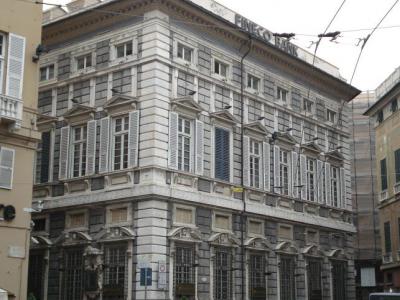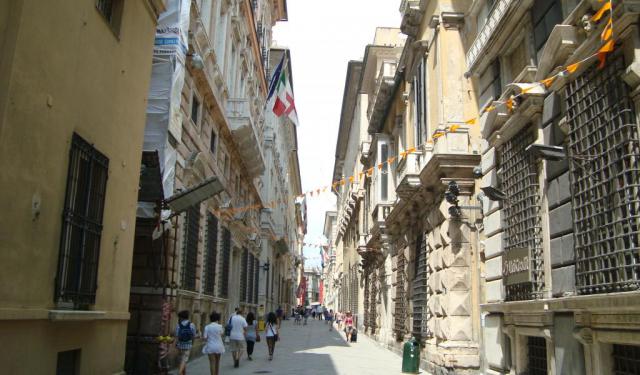Palazzo Pallavicini-Cambiaso (Pallavicini-Cambiaso Palace), Genoa
Pallavicini-Cambiaso Palace is a Renaissance palace, commissioned in 1558 by Agostino Pallavicini, who served as Genoa’s ambassador to the Spanish court. It was the very first grand palace to open onto the prestigious street, setting the tone for the majestic buildings to follow.
Designed by architect Bernardino Cantone, the palace features a refined ashlar façade of rusticated gray stone and white marble trim. Its Mannerist portal, decorated with carved ox skulls (bucrania), and an 18th-century devotional niche mark the entrance. In 1592, it hosted Duke Vincenzo I Gonzaga of Mantua, confirming its high status among Genoa’s ruling families.
Inside, the noble floor is adorned with frescoes that highlight Genoa’s artistic heritage. Visitors can admire The Rape of the Sabines in the reception room and the History of Cupid and Psyche in the grand hall-both masterful creations by Andrea and Ottavio Semino, evoking the humanistic and mythological tastes of the era. Moreover, in the early 1600s, Niccolò Pallavicini, Agostino’s son, hosted Peter Paul Rubens here and commissioned the painter’s portrait of himself and his wife-celebrating the palace’s link to artistic innovation.
Today, the Pallavicini-Cambiaso Palace remains under the ownership of a prominent financial institution, but it continues to shine as a defining feature of the Palaces of the Rolli and the UNESCO-listed New Streets complex. While not regularly open for walkthrough visits, its majestic façade can be admired from the street, and part of its legacy lives on in Rubens’s 1622 engravings.
Designed by architect Bernardino Cantone, the palace features a refined ashlar façade of rusticated gray stone and white marble trim. Its Mannerist portal, decorated with carved ox skulls (bucrania), and an 18th-century devotional niche mark the entrance. In 1592, it hosted Duke Vincenzo I Gonzaga of Mantua, confirming its high status among Genoa’s ruling families.
Inside, the noble floor is adorned with frescoes that highlight Genoa’s artistic heritage. Visitors can admire The Rape of the Sabines in the reception room and the History of Cupid and Psyche in the grand hall-both masterful creations by Andrea and Ottavio Semino, evoking the humanistic and mythological tastes of the era. Moreover, in the early 1600s, Niccolò Pallavicini, Agostino’s son, hosted Peter Paul Rubens here and commissioned the painter’s portrait of himself and his wife-celebrating the palace’s link to artistic innovation.
Today, the Pallavicini-Cambiaso Palace remains under the ownership of a prominent financial institution, but it continues to shine as a defining feature of the Palaces of the Rolli and the UNESCO-listed New Streets complex. While not regularly open for walkthrough visits, its majestic façade can be admired from the street, and part of its legacy lives on in Rubens’s 1622 engravings.
Want to visit this sight? Check out these Self-Guided Walking Tours in Genoa. Alternatively, you can download the mobile app "GPSmyCity: Walks in 1K+ Cities" from Apple App Store or Google Play Store. The app turns your mobile device to a personal tour guide and it works offline, so no data plan is needed when traveling abroad.
Palazzo Pallavicini-Cambiaso (Pallavicini-Cambiaso Palace) on Map
Sight Name: Palazzo Pallavicini-Cambiaso (Pallavicini-Cambiaso Palace)
Sight Location: Genoa, Italy (See walking tours in Genoa)
Sight Type: Attraction/Landmark
Guide(s) Containing This Sight:
Sight Location: Genoa, Italy (See walking tours in Genoa)
Sight Type: Attraction/Landmark
Guide(s) Containing This Sight:
Walking Tours in Genoa, Italy
Create Your Own Walk in Genoa
Creating your own self-guided walk in Genoa is easy and fun. Choose the city attractions that you want to see and a walk route map will be created just for you. You can even set your hotel as the start point of the walk.
Rolli Palaces Walking Tour
The Rolli di Genova – or, more precisely, the Rolli degli alloggiamenti pubblici di Genova (Italian for "Lists of the public lodgings of Genoa") – were first established in the Republic of Genoa in 1576. Originally, these official lists included private palaces and mansions belonging to the most distinguished local families, which - if chosen through a public lottery - were obliged... view more
Tour Duration: 1 Hour(s)
Travel Distance: 0.4 Km or 0.2 Miles
Tour Duration: 1 Hour(s)
Travel Distance: 0.4 Km or 0.2 Miles
Genoa Introduction Walking Tour
Petrarch, an Italian poet of the early Renaissance known as the "father of humanism," called Genoa "La Superba" (The Proud One). Genoa is deservedly proud of her maritime glory and unique architecture.
From the 11th century until the late 18th century, the city became a leading economic and military power in Europe. It was one of the wealthiest cities in the world through... view more
Tour Duration: 2 Hour(s)
Travel Distance: 3.8 Km or 2.4 Miles
From the 11th century until the late 18th century, the city became a leading economic and military power in Europe. It was one of the wealthiest cities in the world through... view more
Tour Duration: 2 Hour(s)
Travel Distance: 3.8 Km or 2.4 Miles





